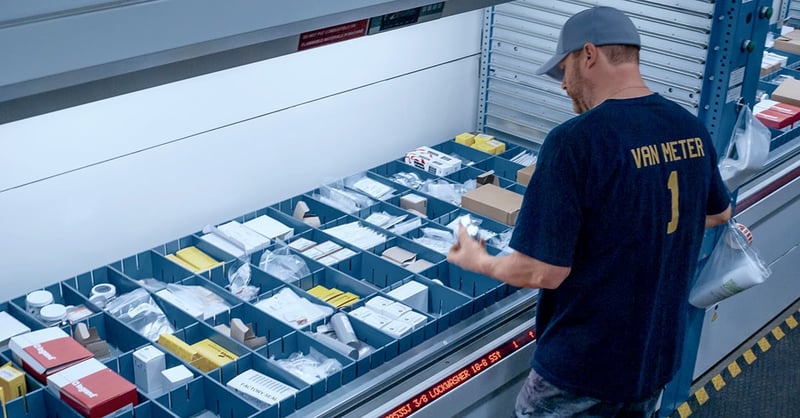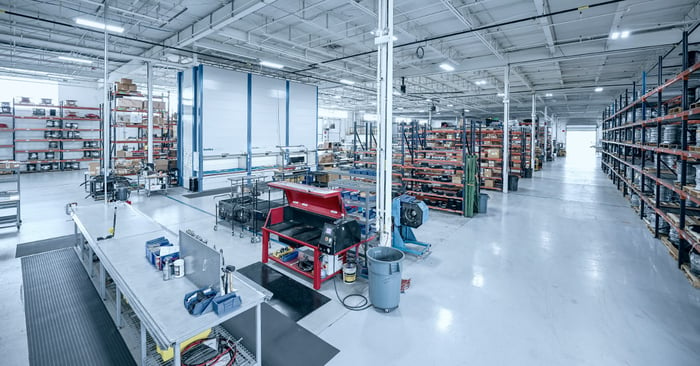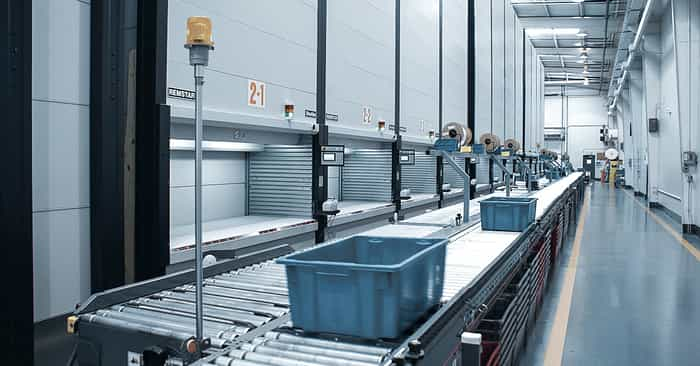An order picking process refers to the steps taken within a warehouse or distribution center to fulfill orders – including retrieving or “picking” items from storage, consolidating them together and delivering them to the correct destination. Order picking is a very common warehouse process found in distribution centers filling end customer orders – either B2C or B2B – as well as within manufacturing operations to support assembly or repair. Orders are commonly picked and shipped to a customer, delivered from the warehouse to a manufacturing line or service repair bay within the same facility or held for pickup. This order picking process encompasses the entire chain of events starting with the order being entered into the system and concluding with the completed order reaching its final destination.
Typically, an order will be sent to the warehouse and “drop” into the warehouse management software (WMS) depending on the level of automation being used in the warehouse. This triggers the start of the order picking process. That order then moves through the warehouse either manually by a worker with a cart, or automatically using an automated solution like conveyor or robotics, or a mix of both. The items collected are placed in bags, totes, bins, trays, or other containers to consolidate the items into one order. As it moves through the warehouse, workers – or automated order picking technologies – will pick the necessary items, add them to the container, and fill the order. Once all items have been picked, the order is moved downstream to a shipping area where the order picking process ends and the order is distributed to the final destination.
The order picking process is a critical function within the broader warehousing world of order fulfillment. Order picking processes themselves account for a huge portion of warehouse operations costs, mostly because of the labor required to sustain an order fulfillment operation. Creating efficiencies within an order picking process is a guaranteed way to keep costs low and save on valuable floorspace.
In the modern era of same-day or two-day delivery, free shipping, and other elevated customer expectations that have come with the explosive growth of e-commerce in the last decade, having an efficient order picking process has become a necessity for many retailers. Efficient order picking processes also lead to faster delivery times, higher order accuracy, and an overall better customer experience.
Different Order Picking Strategies
When it comes to order picking processes there isn’t a one size fits all approach. Most often one picking strategy in combination with one or more of the additional picking methods is utilized to reach the goals of the operation. Operations teams need to consider the profile of the order, distribution of single vs multiple line item orders, material flow, order release timing, the physical layout of the facility, and more when selecting the right order picking process for their operations.
Most warehouses are divided into zones that help organize their inventory. How warehouse managers decide what type of inventory goes in each zone depends on a variety of factors such as item size, velocity, and quantity. For example, one warehouse might have four zones: flow rack for small, fast moving items; static shelving for small, slow-moving items; high bay racking for large, slow-moving items; and automated storage for small, fast and medium-moving items. The types of zones in a warehouse play a large role in selecting an effective order picking strategy.
Here are the three primary order picking strategies used in modern warehouse and distribution centers:
- Pick and pass: Orders move through each zone of the warehouse – each zone “picks” into the order tote and then “passes” the order tote to the next zone until all items are picked into the order tote. The order stays together during the entire order picking process.
- Zone or Parallel picking: Each zone picks items needed for the orders at the same time. These items are sent to a consolidation zone where they are combined into one order and then sent to their final destination.
- Wave picking: All items are picked separately from their orders and sent to a central consolidation zone. Once there, workers separate the items into complete, individual orders.
For a deeper dive: 3 Warehouse Order Picking Strategies to Maximize Throughput and Accuracy
Order Picking Technologies
There are many order picking technologies available to support an effective order picking process that will improve your order fulfillment processes. No matter the solution, the basic elements of the order picking process remain the same. At their most fundamental, these systems support workers with each step of the order picking process in the identification, tracking, verification, organization, storage, location, sorting and handling of inventory as it relates to orders. There are five fundamental technologies that augment an order picking processes:
- 1. Inventory management software: Manages and directs the handling of inventory and people throughout the order picking process.
- Storage systems: Used to physically store goods, can be either static or automated storage and retrieval systems (ASRS).
- Transport systems: Physically moves inventory throughout the warehouse, can be either manual (carts, pallet jacks, lift trucks) or automated (conveyor, robotics).
- Automatic ID and data capture systems: Collect data from during the order picking process and feed it back to the inventory management software.
- Pick indicator systems: Direct operators to specific locations and provide information for the task to be completed, helping them quickly and accurately locate required items.
With so many options available, how do you know what you really need?
For a deeper dive: 5 Order Picking Technologies: Creating the Perfect Warehouse Fulfillment System

Optimizing an Order Picking Process
Having the right order picking process laid out for your order fulfillment operation supports higher accuracy, increased productivity, greater throughput and faster cycle times in order picking—ultimately maximizing efficiency while boosting customer satisfaction. There are plenty of tips and tricks for optimizing order picking, but here are the top three things to consider when optimizing an order picking process:
- Choose the correct picking strategy: Your picking strategy is the core of your order picking process. Picking the correct one is the #1 way you can optimize your order picking.
- Focus on facility flow: Organize your warehouse based on the flow in which inventory travels through each functional area. Each area should logically lead to the next, eliminating backtracking and reducing travel time for workers.
- Utilize bins, totes and dividers: Whether it’s stored in on shelves, rack or in an automated system, sub-dividing inventory with reusable plastic bins, totes and dividers makes it easier to find what you’re looking for faster.
These are just a few tips on how to get started on optimizing your order picking process. For a more complete list, check out: 15 Best Practices for Optimizing Your Order Picking Operation.





